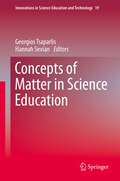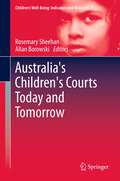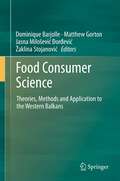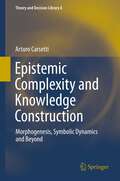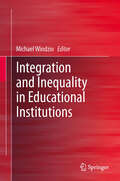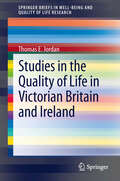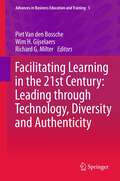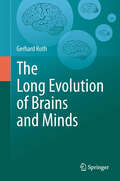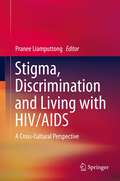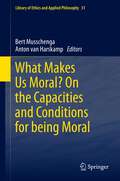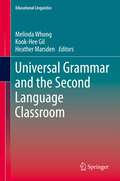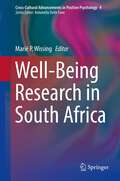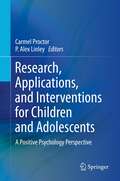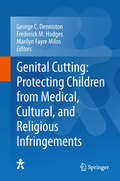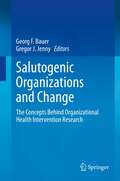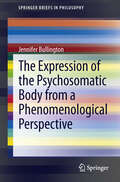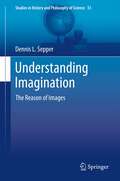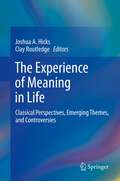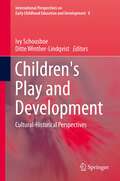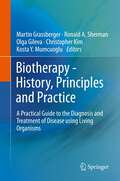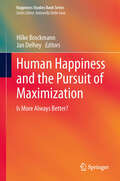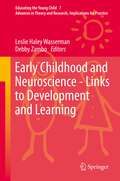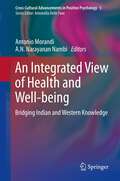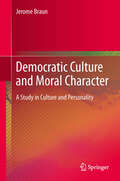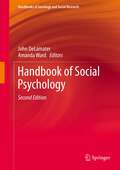- Table View
- List View
Concepts of Matter in Science Education (Innovations in Science Education and Technology #19)
by Georgios Tsaparlis Hannah SevianBringing together a wide collection of ideas, reviews, analyses and new research on particulate and structural concepts of matter, Concepts of Matter in Science Education informs practice from pre-school through graduate school learning and teaching and aims to inspire progress in science education. The expert contributors offer a range of reviews and critical analyses of related literature and in-depth analysis of specific issues, as well as new research. Among the themes covered are learning progressions for teaching a particle model of matter, the mental models of both students and teachers of the particulate nature of matter, educational technology, chemical reactions and chemical phenomena, chemical structure and bonding, quantum chemistry and the history and philosophy of science relating to the particulate nature of matter. The book will benefit a wide audience including classroom practitioners and student teachers at every educational level, teacher educators and researchers in science education. "If gaining the precise meaning in particulate terms of what is solid, what is liquid, and that air is a gas, were that simple, we would not be confronted with another book which, while suggesting new approaches to teaching these topics, confirms they are still very difficult for students to learn". Peter Fensham, Emeritus Professor Monash University, Adjunct Professor QUT (from the foreword to this book)
Australia's Children's Courts Today and Tomorrow (Children’s Well-Being: Indicators and Research #7)
by Rosemary Sheehan Allan BorowskiThe Children's Court is one of society's most important social institutions. At the same time, it is steeped in controversy. This is in large measure due to the persistence and complexity of the problems with which it deals, namely, juvenile crime and child abuse and neglect. Despite the importance of the Children's Court as a means of holding young people accountable for their anti-social behaviour and parents for the care of their children, it has not been the subject of close study. Certainly it has not been previously studied nationally. This book, an edited collection, is based on the findings of study that spanned the six States and two Territories of Australia. The study sought to examine the current challenges faced by the Children's Court and to identify desirable and feasible directions for reform in each State and Territory. A further unique feature of this study is that it canvassed the views of judges and magistrates who preside over this court.
Food Consumer Science
by Dominique Barjolle Jasna Milošević Đorđević Žaklina Stojanović Matthew GortonThis book explores the main methods, models, and approaches of food consumer science applied to six countries of the Western Balkans, illustrating each of these methods with concrete case studies. Research conducted between 2008 and 2011 in the course of the FOCUS-BALKANS project forms an excellent database for exploring recent changes and trends in food consumption.
Epistemic Complexity and Knowledge Construction
by A. CarsettiThe volume as its first target aims at clarifying that peculiar entanglement of complexity, causality, meaning, emergence and intentionality that characterises the unfolding of the "natural forms" of human cognition As is well known, cognition is not only a self-organising process. It is also a co-operative and coupled process. If we consider the external environment as a complex, multiple and stratified Source which interacts with the nervous system, we can easily realise that the cognitive activities devoted to the "intelligent" search for the depth information living in the Source, may determine the very change of the complexity conditions according to which the Source progressively expresses its "wild" action. In this sense, simulation models are not neutral or purely speculative: the true cognition actually appears to be necessarily connected with successful forms of reading, those forms, in particular, that permit a specific coherent unfolding of the deep information content of the Source. Therefore, the simulation models, if valid, materialise as "creative" channels, i.e., as autonomous functional systems, as the very roots of a new possible development of the entire system represented by mind and its Reality. From a general point of view, the objectivity of Reality is also proportionate to the autonomy reached by cognitive processes. In this sense, at the level of cultural evolution, reference procedures act as guide, mirror and canalisation with respect to primary information flows and involved selective forces: they offer themselves as the actual instruments for the constant renewal of the code, for the invention and the actual articulation of an ever-new incompressibility. From an effective point of view, they appear as indissolubly linked to the successive definition of specific (and innovative) measures of the epistemic complexity. These measures cannot concern only statistical rarity (Shannon) or computational incompressibility (Kolmogorov-Chaitin), on the contrary they should also be able to take into account the coupled connection between the Source and the cognitive agent, the evolution of this connection as well as the successive constitution of meaning as symbolic form. Hence the possible (and necessary) definition of new axiomatic systems, new measure spaces, the real displaying of processes of continuous reorganisation at the semantic level. Indeed, it is only through a complete, first-order "reduction" and a correlated non-standard second-order analysis that new incompressibility will actually manifest itself. Therefore, the reference procedures appear to be related to a process of multiplication of minds, as well as to a process of "clarification" of meanings which finally emerges as vision via principles.
Integration and Inequality in Educational Institutions
by Michael WindzioThis volume addresses questions that lie at the core of research into education. It examines the way in which the institutional embeddedness and the social and ethnic composition of students affect educational performance, skill formation, and behavioral outcomes. It discusses the manner in which educational institutions accomplish social integration. It poses the question of whether they can reduce social inequality, - or whether they even facilitate the transformation of heterogeneity into social inequality. Divided into five parts, the volume offers new insights into the many factors, processes and policies that affect performance levels and social inequality in educational institutions. It presents current empirical work on social processes in educational institutions and their outcomes. While its main focus is on the primary and secondary level of education and on occupational training, the book also presents analyses of institutional effects on transitions from vocational training into tertiary educational institutions in an interdisciplinary and internationally comparative approach.
Studies in the Quality of Life in Victorian Britain and Ireland
by Thomas E. JordanThis work examines mortality among young children in the period from the seventeenth to the nineteenth century. It does so using several types and sources of information from the census unit England and Wales, and from Ireland. The sources of information used in this study include memoirs, diaries, poems, church records and numerical accounts. They offer descriptions of the quality of life and child mortality over the three centuries under study. Additional sources for the nineteenth century are two census-derived numerical indexes of the quality of life. They are the VICQUAL index for England and Wales, and the QUALEIRE index for Ireland. Statistical procedures have been applied to the numbers provided by the sources with the aim to identify effects of and associations between such variables as gender, age, and social background. The book examines the results to consider the impact of children's deaths upon parents and families, and concludes that there are differences and continuities across the centuries.
Facilitating Learning in the 21st Century: Leading through Technology, Diversity and Authenticity
by Wim H. Gijselaers Piet Van den Bossche Richard G. MilterThis book tackles the latest challenges in education in the business sector, outlining how the students of the future must be taught to adapt to a highly fluid business environment in which their ability to acquire new skills and collaborate with others is more important than possessing facts. Taking its cue from the growing body of theory advocating multi-faceted and often multilingual education, the book focuses on 'competences' and collaborative, team-oriented, project-based learning. Beginning with a set of studies on the differences in individual learning and ways of supporting students, the volume moves on to a collection of papers on learning at the level of the group, which include material on team learning, and the sharing of knowledge in problem-based learning. The editors view these factors in education as an inevitable feature of pedagogy, reflecting the fact that knowledge, and its acquisition, is increasingly collaborative in our working lives, and especially in business. A final section applies the principles developed in the first two parts at an organizational level, evaluating the enormous implications these developments in our ideas about learning have for the educational institutions charged with teaching future generations. Combining research and theory with practical factors in business education and training, the volume provides wide-ranging perspectives on developing best practice in the sector.
The Long Evolution of Brains and Minds
by Gerhard RothThe main topic of the book is a reconstruction of the evolution of nervous systems and brains as well as of mental-cognitive abilities, in short "intelligence" from simplest organisms to humans. It investigates to which extent the two are correlated. One central topic is the alleged uniqueness of the human brain and human intelligence and mind. It is discussed which neural features make certain animals and humans intelligent and creative: Is it absolute or relative brain size or the size of "intelligence centers" inside the brains, the number of nerve cells inside the brain in total or in such "intelligence centers" decisive for the degree of intelligence, of mind and eventually consciousness? And which are the driving forces behind these processes? Finally, it is asked what all this means for the classical problem of mind-brain relationship and for a naturalistic theory of mind.
Stigma, Discrimination and Living with HIV/AIDS
by Pranee LiamputtongUp until now, many articles have been written to portray stigma and discrimination which occur with people living with HIV/AIDS (PLWHA) in many parts of the world. But this is the first book which attempts to put together results from empirical research relating to stigma, discrimination and living with HIV/AIDS. The focus of this book is on issues relevant to stigma and discrimination which have occurred to individuals and groups in different parts of the globe, as well as how these individuals and groups attempt to deal with HIV/AIDS. The book comprises chapters written by researchers who carry out their projects in different parts of the world and each chapter contains empirical information based on real life situations. This can be used as an evidence for health care providers to implement socially and culturally appropriate services to assist individuals and groups who are living with HIV/AIDS in many societies. The book is of interest to health care providers who have their interests in working with individuals and groups who are living with HIV/AIDS from a cross-cultural perspective. It will be useful for students and lecturers in courses such as anthropology, sociology, social work, nursing, public health and medicine. In particular, it will assist health workers in community health centres and hospitals in understanding issues related to HIV/AIDS and hence provide culturally sensitive health care to people living with HIV/AIDS from different social and cultural backgrounds. The book is useful for anyone who is interested in HIV/AIDS-related stigma and discrimination in diverse social and cultural settings.
What Makes Us Moral? On the capacities and conditions for being moral
by Bert Musschenga Anton Van HarskampThis book addresses the question of what it means to be moral and which capacities one needs to be moral. It questions whether empathy is a cognitive or an affective capacity, or perhaps both. As most moral beings behave immorally from time to time, the authors ask which factors cause or motivate people to translate their moral beliefs into action? Specially addressed is the question of what is the role of internal factors such as willpower, commitment, character, and what is the role of external, situational and structural factors? The questions are considered from various (disciplinary) perspectives.
Universal Grammar and the Second Language Classroom
by Kook-Hee Gil Heather Marsden Melinda WhongThis book proposes that research into generative second language acquisition (GenSLA) can be applied to the language classroom. Assuming that Universal Grammar plays a role in second language development, it explores generalisations from GenSLA research. The book aims to build bridges between the fields of generative second language acquisition, applied linguistics, and language teaching; and it shows how GenSLA is poised to engage with researchers of second language learning outside the generative paradigm. Each chapter of Universal Grammar and the Second Language Classroom showcases ways in which GenSLA research can inform language pedagogy. Some chapters include classroom research that tests the effectiveness of teaching particular linguistic phenomena. Others review existing research findings, discussing how these findings are useful for language pedagogy. All chapters show how generative linguistics can enhance teachers' expertise in language and second language development. "This groundbreaking volume ably takes on the gap that currently exists between generative linguistic theory in second language acquisition (GenSLA) and second language pedagogy, by gathering chapters from GenSLA researchers who are interested in the relevance and potential application of their research to second/foreign language teaching. It offers a welcome and thought-provoking contribution to any discussion of the relation between linguistic theory and practice. I recommend it not only for language teachers interested in deepening their understanding of the formal properties of the languages they teach, but also for linguists interested in following up on more practical consequences of the fruits of their theoretical and empirical research." Donna Lardiere, Georgetown University, Washington DC, USA
Well-Being Research in South Africa
by Marié P. WissingThis is the first book to bring together examples of research in positive psychology / psychofortology conducted in the multi-cultural South African context with its diverse populations and settings. The volume reflects basic as well as applied well-being research in the multicultural South African context, as conducted in various contexts and with a variety of methods and foci. Theoretical, review, and empirical research contributions are made, reflecting positivist to constructivist approaches, and include quantitative, qualitative, and mixed-method approaches. Some findings support universality assumptions, but others uncovered unique cultural patterns. Chapters report on well-being research conducted in the domains of education, work, health, and family, and in clinical, urban vs. rural, and unicultural vs. multicultural contexts. Studies span the well-being of adolescents, adults, and older people, and topics include resilience in individuals, families, and groups, measurement issues and coping processes, the role of personal and contextual variables, and facets such as hope, spirituality, self-regulation, and interventions.
Research, Applications, and Interventions for Children and Adolescents: A Positive Psychology Perspective
by Carmel Proctor P. Alex LinleyThis book presents recent positive psychological research, applications and interventions being used among adolescents and children. Currently there is a wave of change occurring whereby educators, and others working with children and adolescents, are beginning to recognize the benefits of looking at well-being from a positive perspective, specifically the integration of positive psychological theory into the school curriculum in order to improve student well-being. Moreover, although the positive psychological field has grown tremendously since its inception, there remains an imbalance in the publication of research findings, applications, and interventions among children and adolescents in comparison to adults. This book fills the need for a reference to this valuable information and benefits a wide range of professionals, including educators, clinicians, psychologists, students, and many other working with children and adolescents.
Genital Cutting: Protecting Children from Medical, Cultural, and Religious Infringements
by Frederick M. Hodges Marilyn Fayre Milos George C. DennistonThis volume contains the proceedings of the 10th International Symposium on Circumcision, Genital Integrity, and Human Rights. Authors are international experts in their fields, and the book contains the most up-to-date information on the issue of genital cutting of infants and children from medical, legal, bioethical, and human rights perspectives.
Salutogenic organizations and change: The concepts behind organizational health intervention research
by Gregor J. Jenny Georg F. BauerNew and current approaches to organizational health intervention research are the main focus of this comprehensive volume. Each chapter elaborates on the respective intervention researcher's concept of a healthy organization, his/her approach to changing organizations, and how to research these interventions in organizations. As a common ground, the book consistently relates to the notion of salutogenesis, focusing on resources and positive outcomes of health-oriented organizational change processes. Out of the virtual dialogue between the chapters, common themes and potential trends for the future are identified.
The Expression of the Psychosomatic Body from a Phenomenological Perspective
by Jennifer BullingtonThis book is a contribution to the understanding of psychosomatic health problems. Inspired by the work of the French phenomenologist Maurice Merleau-Ponty, a phenomenological theory of psychosomatics is worked out as an alternative to traditional, biomedical thinking. The patient who presents somatic symptoms with no clearly discernible lesion or dysfunction presents a problem to the traditional health care system. These symptoms are medically unexplainable, constituting an anomaly for the materialistic understanding of ill health that underlies the practice of modern medicine. The traditional biomedical model is not appropriate for understanding a number of health issues that we call "psychosomatic" and for this reason, biomedical theory and practice must be complemented by another theoretical understanding in order to adequately grasp the psychosomatic problematic. This book establishes a complementary understanding of psychosomatic ill health in terms of a non-reductionistic model allowing for the (psychosomatic) expression of the lived body. A thorough presentation of the work Merleau-Ponty is followed by the author's application of his thinking to the phenomenon of psychosomatic pathology.
Understanding Imagination: The Reason of Images
by Dennis L SepperThis book discusses that imagination is as important to thinking and reasoning as it is to making and acting. By reexamining our philosophical and psychological heritage, it traces a framework, a conceptual topology, that underlies the most disparate theories: a framework that presents imagination as founded in the placement of appearances. It shows how this framework was progressively developed by thinkers like Plato, Aristotle, Descartes, and Kant, and how it is reflected in more recent developments in theorists as different as Peirce, Saussure, Wittgenstein, Benjamin, and Bachelard. The conceptual topology of imagination incorporates logic, mathematics, and science as well as production, play, and art. Recognizing this topology can move us past the confusions to a unifying view of imagination for the future.
The Experience of Meaning in Life: Classical Perspectives, Emerging Themes, and Controversies
by Joshua A. Hicks Clay RoutledgeThis book offers an in-depth exploration of the burgeoning field of meaning in life in the psychological sciences, covering conceptual and methodological issues, core psychological mechanisms, environmental, cognitive and personality variables and more.
Children's Play and Development: Cultural-Historical Perspectives (International Perspectives on Early Childhood Education and Development #8)
by Ditte Winther-Lindqvist Ivy SchousboeThis book provides new theoretical insights to our understanding of play as a cultural activity. All chapters address play and playful activities from a cultural-historical theoretical approach by re-addressing central claims and concepts in the theory and providing new models and understandings of the phenomenon of play within the framework of cultural historical theory. Empirical studies cover a wide range of institutional settings: preschool, school, home, leisure time, and in various social relations (with peers, professionals and parents) in different parts of the world (Europe, Australia, South America and North America). Common to all chapters is a goal of throwing new light on the phenomenon of playing within a theoretical framework of cultural-historical theory. Play as a cultural, collective, social, personal, pedagogical and contextual activity is addressed with reference to central concepts in relation to development and learning. Concepts and phenomena related to ZPD, the imaginary situation, rules, language play, collective imagining, spheres of realities of play, virtual realities, social identity and pedagogical environments are presented and discussed in order to bring the cultural-historical theoretical approach into play with contemporary historical issues. Essential as a must read to any scholar and student engaged with understanding play in relation to human development, cultural historical theory and early childhood education.
Biotherapy - History, Principles and Practice: A Practical Guide to the Diagnosis and Treatment of Disease using Living Organisms
by Martin Grassberger Christopher M.H. Kim Kosta Y. Mumcuoglu Olga S. Gileva Ronald A. ShermanBiotherapy is defined as the use of living organisms in the treatment and diagnosis of human and animal diseases. This volume is an evocative exploration of the history, scientific basis and practical use of the major biotherapy modalities. The authors provide researchers and practitioners interested in this field, with cutting-edge material on the latest key advances in the following fields of biotherapy: Maggot Therapy, Hirudotherapy, Bee Venom Therapy, Apitherapy, Ichthyotherapy, Helminth Therapy, Phage Therapy, Animal Assisted Therapy, Canine Olfactory Detection. In addition, the authors provide with their chapters an extensive bibliography that represents a state-of-the-art survey of the literature. Comprehensive and current, this fresh volume of reviews is an essential resource for professionals who need to stay ahead of the game in the exciting field of biotherapy.
Human Happiness and the Pursuit of Maximization: Is More Always Better?
by Hilke Brockmann Jan DelheyThis book tests the critical potential of happiness research to evaluate contemporary high-performance societies. These societies, defined as affluent capitalist societies, emphasize competition and success both institutionally and culturally. Growing affluence improves life in many ways, for a large number of people. We lead longer, safer, and more comfortable lives than previous generations. But we also live faster, and are competition-toughened, like top athletes. As a result, we suspect limits and detect downsides of our high-speed lives. The ubiquitous maximization principle opens up a systematic gateway to the pleasures and pains of contemporary life. Using happiness as a reference point, this book explores the philosophical and empirical limits of the maximization rule. It considers the answer to questions such as: Precisely, why did the idea of (economic) maximization gain so much ground in our Western way of thinking? When, and in which life domains, does maximization work, when does it fail? When do qualities and when do quantities matter? Does maximization yield a different (un)happiness dividend in different species, cultures, and societies?
Early Childhood and Neuroscience - Links to Development and Learning
by Leslie Haley Wasserman Debby ZamboInformation from neuroscience is growing and being properly used, and misused wich makes it imperative that educators receive accurate and practical information. This book provides the accurate and practical information educators (pre-service and in-service) and caregivers serving children birth through age 8 need to know. This volume takes a practical and cautionary stance. It reminds educators to consider the ethical implications of neuroscience when it is applied to education, reviews current findings from neuroscience and reveals the dangers of oversimplification and inappropriate extensions of neuroscience into curricula. It brings together a group of authors with varied expertise writing on an array of inter-related educational topics that will help educators use neuroscience to understand and address the cognitive, emotional, social, and behavioral needs of all young children, including those with exceptionalities. They believe neuroscience can be insightful and useful to educators if applied ethically and with care. The book offers strategies educators and caregivers can use to affect children today and the adults they can become.
An Integrated View of Health and Well-being: Bridging Indian and Western Knowledge (Cross-Cultural Advancements in Positive Psychology #5)
by A.N.Narayanan Nambi Antonio MorandiConcepts like Health and Well-being are not exclusive products of the Western culture. Research has widely demonstrated that the representation of the body and of its pathologies, as well as treatment and healing practices vary across cultures in relation to social norms and beliefs.The culture of India is a melting pot of nine main Darshanas, or philosophical systems, that share the common core of a realization of the self in society. India's traditional health system, Ayurveda, is a result of the practical application of the Darshanas to the observation of human nature and behavior. Ayurveda conceptualizes health, disease and well-being as multidimensional aspects of life, and it seeks to preserve a balance in individuals among their biological features, their psychological features and their environmental demands. The Ayurveda approach to health is remarkably similar to the eudaimonic conceptualization of well-being proposed by positive psychology, and the basic tenets of Ayurveda are deeply consistent with the latest developments of modern physics, which stresses the substantial interconnectedness among natural phenomena and their substrates. This text shows how the approach to health developed in Ayurveda can be fruitfully integrated in a general view of health and well-being that encompasses cultural and ideological boundaries. Specifically, it details the conceptualization of health as an optimal and mindful interaction between individuals and their environment.
Democratic Culture and Moral Character
by Jerome BraunThis book returns critical theory to its roots in both psychology and the social sciences. It shows some of the relationships between equality in a political and social sense and personal identity that either relates well to such equality, or rebels against it. All this reflects processes of social and cultural influence that involve not only random change but also processes of social and cultural evolution that themselves have effects regarding potentials for self-fulfillment and even public morality. This book provides a framework to help one study the interaction between individual aspirations and social opportunities. Jerome Braun, known for his writings in interdisciplinary social science, an approach he calls pragmatic critical theory, here provides a book that discusses issues relevant to the moral underpinnings of democratic society, including issues of social evolution and of culture and personality. This book will be of particular interest to scholars and students of Psychology (particularly in the areas of Psychology of Personality and Cultural Psychology), Sociology (especially those interested in Sociology of Alienation and Sociology of Culture, as well as Sociology of Mental Health), Anthropology (particularly in the area of Psychological Anthropology), Cultural Studies, and Social Theory in general.
Handbook of Social Psychology
by Amanda Ward John DelamaterThis handbook provides a broad overview of the field of social psychology and up-to-date coverage of current social psychological topics. It reflects the recent and substantial development of the field, both with regard to theory and empirical research. It starts out by covering major theoretical perspectives, including the interactionist, identity, social exchange, social structure and the person perspectives. Next, it discusses development and socialization in childhood, adolescence and adulthood. In addition to updated discussions of topics that were included in the first edition, the part examining personal processes includes entirely new topics, such as social psychology and the body and individual agency and social motivation. Interpersonal processes are discussed from a contemporary perspective with a focus on stress and health. The final section examines the person in sociocultural context, and includes another topic new to the second edition, the social psychology of race and gender and intersectionality.
